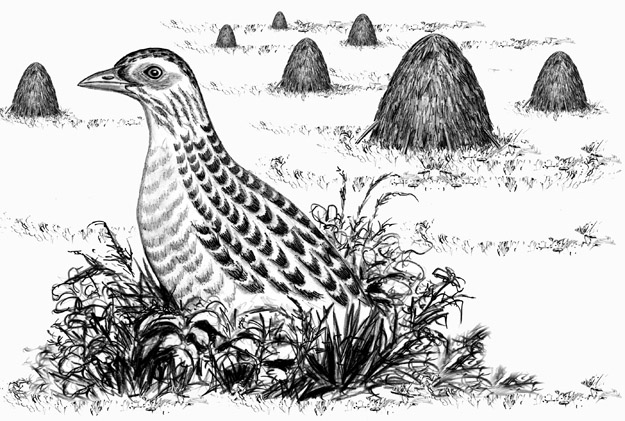
Dear Bird Folks,
When I was growing up in Ireland I remember hearing and seeing Corncrakes. Now these birds aren’t seen anymore. What has happened to the Corncrakes?
– Tom O’Leary, Cape Cod, MA
Come on, Tom,
Who are you kidding? You’re not from Ireland. A name like Tom O’Leary doesn’t even sound Irish. (Don’t worry. I’m not going to ask for your birth certificate. We’ve had enough of that silliness for one century.) And what is this bird you are asking about, a “Corncrake”? There’s no such bird. Aren’t corncrakes snacks they sell at county fairs? They are usually served hot with sugar and sold in a booth that sits right next to the corndog stand (or in Ireland, right next to the potato ‘n mutton stand). The last time I went to a fair I ate a whole plate of corncrakes, plus two corndogs and a bucket of hushpuppies. Ugh! By the end of the day, the guy who tried to guess my weight needed to use two scales.
Corncrakes, as it turns out, actually are birds. They are in the rail family. Rails are weird, chicken-like birds, with long toes, longer legs and skinny bodies. (Their skinny bodies make them different than chubby chickens, or me after a trip to the county fair.) Rails are a paranoid lot. They spend most of their lives living in wetlands where they hide in dense reeds, using their slim bodies to slip through the vegetation undetected. (The expression “skinny as a rail” actually comes from these thinly built birds. Really.) Corncrakes are the black sheep of the rail family. Often called “land rails,” Corncrakes have no use for the soggy wetlands that other rails relish. They like to live inland, in hay fields, away from swampy water and all those icky bugs. Unfortunately, it is their love of hay fields that has led to the Corncrakes’ downfall. It seems these birds have big problem with hay fever and the constant sneezing betrays their location to predators. (That last line is totally untrue. I just want to see if anyone is still paying attention.)
For centuries Corncrakes prospered in and around the farms of Ireland, as well as in other European countries. Each spring the birds would arrive from their wintering grounds in Africa and begin to breed in the green hay fields that Ireland is famous for. Upon reaching the breeding grounds the male starts repeating his two-note song over and over until he attracts a mate. This surprises me because I think the Corncrake has one of the worst songs of any bird. This bird is no Irish tenor. He sounds like a cross between a cricket with laryngitis and a guy in corduroys scratching himself. Fortunately for Mr. Corncrake, my vote means nothing because this awful song works. The females can’t get enough of it. Quite often the male not only finds one mate, but he attracts several. I don’t get it. The lady Corncrakes must really dig corduroy.
Because corncrakes are so shy and secretive, acquiring an accurate natural history on these birds has been a challenge. It was first thought that the females built the nest, but now it is believed that the males do all the work. Whatever. Somebody builds the nest and then the female lays a large clutch of eggs. (I’m pretty sure it’s the female that lays the eggs) After she sits on the eggs for three weeks, the tiny crakes hatch out and spend the next five weeks eating and hiding in the tall grass. This is where the trouble begins.
Back in ancient times, which in Ireland was only about three years ago, farmers used horse-drawn machinery to cut their hay. This process was slow, allowing the crakes ample time to avoid being “harvested” along with the hay. Modern farming equipment is much faster. The tiny crakes have little chance to escape. The other problem is that the new machinery is so efficient the farmers are able to cut just about all the grass they can find. So the birds that do manage to escape the cutters have no place to hide once the harvesting is over. They are now susceptible to natural predators and the dreaded cats. Over the past century the once thriving population of Irish Corncrakes has dwindled down to just a few hundred birds.
The news is not bad for all the Corncrakes. In other parts of their range, namely Russia, the birds are still holding their own. In addition, Ireland is aware of the Corncrakes’ decline and they are taking steps to save the bird. They have set up a Corncrake hot line so farmers can call for Corncrake advice. (Corncrake hot line? Wouldn’t you love to listen in on that conversation?)
I’m glad you asked about Corncrakes, Tom. Those birds have a soft spot in my heart, too. My very first bird book was the Golden Guide to Birds of North America. In the book was a picture of a Corn Crake. (In North America Corn Crake is written as two words, while in Europe it’s only one. This is probably due to the fact that Europe is overcrowded and they try to save space wherever possible.) This odd bird with the odd name caught my attention, but I’ve never seen one. Only rarely does the occasional lost bird find its way to our shores. (More recent bird books don’t even mention it.) No one is sure why migrating Corncrakes sometimes become so lost that they mistakenly fly from Ireland all the way to North America, but I’d bet a late night stop off at a pub had something to do with it.